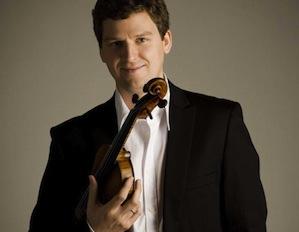Most musicians love to play chamber music. Even if a recital is a challenge to pull off, the musician enjoys the close communication with listeners as much as the audience loves the excitement of being in communion with a great artist — seeing the sweat bead on his forehead, feeling the ferocious concentration, watching the absurdly superhuman technique and racing fingers. On this list of great recitals bound for the Bay Area, you’ll find not only great music but also artists with whom you’ll enjoy spending an evening or afternoon.
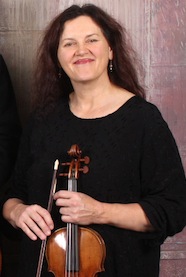
Art of the Baroque Violin: Elizabeth Blumenstock and Voices of Music
Star violinist Elizabeth Blumenstock, in flight, doesn’t alight anywhere until she’s done, and she generally dazzles you before she deigns to perch on the smallest twig. This recital looks terrific: What else can you say about a program that casually sneaks in a Bach solo-violin Partita among the manifold 17th-century goodies that Voices of Music specialize in?
Jan. 19, 8 p.m., All Saints Episcopal Church, Palo Alto; Jan. 20, 8 p.m., St. Stephen’s Church, Belvedere; Jan. 21, 8 p.m., St. Mark’s Lutheran Church, San Francisco; Jan. 22, 7:30 p.m., St. Alban’s Episcopal Church, Albany, $25–$35, (415) 260-4687
Takács Tours the Eurozone, at Hertz Hall

I suppose I’m getting to be a bore about the Takács Quartet, but all the same it’s a wonder to see them grow together. The February program is a delicious one, featuring as it does the Debussy Quartet, Britten’s Third, and Janáček’s Second.
The Britten, about the last thing the composer finished, is mysteriously described as being “in G Major” on the Cal Performances website. I am reminded of the couple-decades-old Alban Berg Quartet recording of the Bartók quartets that insisted on assigning keys to all of them — No. 3 was in C-sharp minor, No. 4 in C major, No. 5 in B-flat major, and so forth. If the Britten Third is in any key at all, it’s certainly E major, which is where its last and longest movement spends almost all its time.
This recital is not to be missed, though. Especially to hear Geraldine Walther, in Janáček’s “Intimate Letters” quartet, which is violistic paradise. It’s been rumored for a couple of years that the Takács are recording both Janáček quartets.
Feb. 19, 3 p.m., Hertz Hall, UC Berkeley, $60+, (510) 642-9988
Afiara Quartet, Music at Kohl Mansion
Just when you thought winter was gone, along comes the Nordic spring. Bless the Afiara Quartet (all Canadians, but quartet in residence at San Francisco State University for several years, until moving to the Juilliard School) for programming Sibelius’ great Voces intimae, and an early Nielsen quartet, to boot.
March 18, 7 p.m., Kohl Mansion, Burlingame, $15–$45, (650) 762-1130
James Ehnes With Orion Weiss
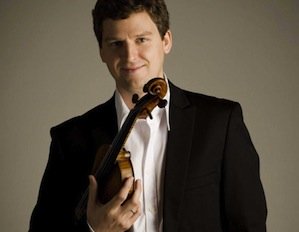
Suddenly, James Ehnes seems to be everywhere, and with good reason. His Bartók recording project (the concertos — violin and viola — have been released, and the sonatas and rhapsodies with piano are pending) hasn’t gotten around to the Solo Sonata so far, but I can’t think of many violinists better equipped to do a spectacular job of it.
The rest of the program consists of the music an all-around musician would program — at least, the type who has a wicked bow-arm, a tender tone, and an affection for Mozart. I recently said that describing Ehnes as “the Jascha Heifetz of our day” was silly, but that’s premature; I haven’t heard him play the Saint-Saëns First Sonata yet. He might still out-Heifetz Heifetz. Certainly he could, if he wished, tear that sonata to bits, in a good way.
The Fauré First Sonata would seem to be right up Ehnes’ alley — lyrical, but with those flashy bits in which he excels. The Mozart he’s playing is a sort of musicological curiosity, in that Mozart wrote out the violin part for performance, but didn’t have time to write down the piano part until after the premiere; he just played what was in his head. It’s a story that makes even the helter-skelter writing of the “Linz” Symphony look tame, but that’s your basic Mozart; if you can write almost literally on the fly, why wouldn’t you? The piece shows no signs of being dashed off, but then neither does the “Linz.”
April 2, 8 p.m., Herbst Theatre, San Francisco, $48, (415) 759-1756
Quatuor Mosaïques, Stanford Lively Arts
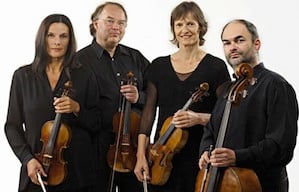
One of these years, this outstanding period-instrument quartet will (I hope) favor Bay Area audiences with the Bartók and Webern it’s been playing in recent years. Still, its Stanford Lively Arts program in April will be as close as you can get to that level of experimentation without straying into the 20th century.
Haydn’s Op. 20/3 is an amazing work, from its opening (with two seven-bar phrases that make you wonder whatever might come next — and sometimes I guarantee you’ll guess wrong, unless you already know the piece), to one of the deepest (and most cello-friendly) slow movements Haydn ever wrote, to a skittish finale in which the second violin gets unexpected attention.
On the other end of the program is Beethoven’s Op. 95, called “Serioso.” This is Beethoven’s tautest and, well, meanest quartet, but with its moments of not-quite-quiet rest, as well. In between comes Mozart’s “Hunt” Quartet, which in this context might seem indecently cheerful, but which also has a slow movement of surpassing depth.
East Bay audiences can hear this Viennese group, an offshoot of Concentus Musicus Wien, in a slightly more genial mood at First Congregational Church in Berkeley one day earlier (April 13). The group’s Cal Performances program consists of Haydn’s Op. 76/4 (“Sunrise”), an early Mendelssohn work, and Schubert’s A Minor, D. 804.
April 14, 8 p.m., Dinkelspiel Auditorium, $44–$50, (650) 725-ARTS (2787)
New Esterházy Quartet With Benjamin Simon at the Freight & Salvage
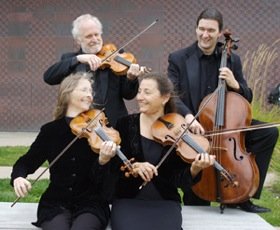
Having performed all of Haydn’s quartets in public over the course of a few seasons, the New Esterházy Quartet has been turning its attention to works by his colleagues, contemporaries, and even pupils. There isn’t a concert in the Quartet’s 2012 lineup that I’d want to miss (Boccherini, Onslow, and Schubert with Elisabeth LeGuin as guest cellist, and then Beethoven’s Op. 132!). Nevertheless, the palm goes to its April 30 performance at Berkeley’s Freight & Salvage: probably the first public performance in a couple hundred years of Anton Wranitzky’s string-quintet arrangement of Haydn’s Creation, which was the very first publication of the oratorio in any form.
(Full disclosure: The parts weren’t “unearthed by the intrepid baroque detectives of the New Esterházy String Quartet,” per San Francisco Chamber Orchestra’s website; my husband and I lent them. All the more reason I’m eager to see this arrangement performed at last.)
Apr. 30, 8 p.m., Freight & Salvage, Berkeley, $8.50–$10.50
Steven Isserlis and Robert Levin Play Beethoven, San Francisco Performances
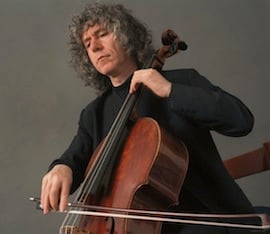
Steven Isserlis performing all of Beethoven’s cello music is a treat; his doing it in company with fortepianist Robert Levin promises to be an adventure. I don’t honestly know what you can expect in their two recitals next May. The programs are neatly divvied up, with the beloved A-major Sonata sharing company with one of the Opus 5 Sonatas, the Horn Sonata transcription, and two of the variation sets, while the second program gets the other Op. 5 Sonata, the other variation set, and the two strange, decidedly quirky late sonatas. I think if I had to choose one, it’d be the latter, but I’d far rather not choose at all.
May 19, 8 p.m. and May 20, 7 p.m., Herbst Theatre, $38–$60

